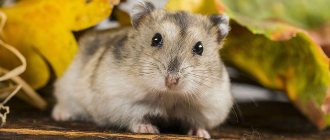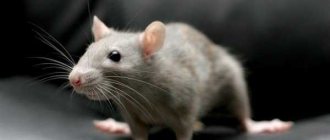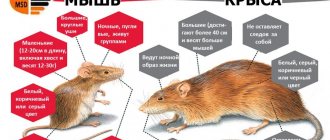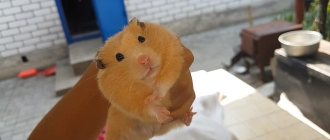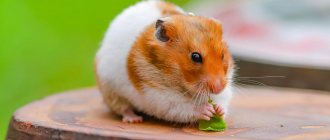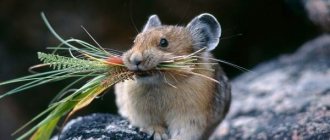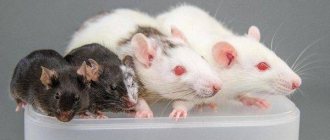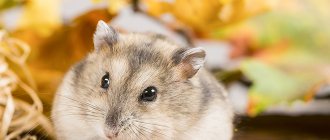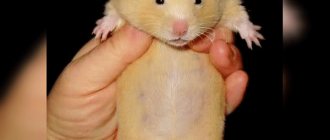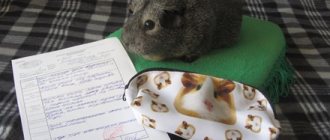- home
- General information
11/01/2018 Distinguishing dzhungarik from Campbell is not an easy task. These two popular varieties of dwarf hamsters are similar in appearance, which is why they are confused by inexperienced sellers in pet stores, misleading buyers. When purchasing a hamster, it is extremely important to know its breed correctly. This is directly related to the character of the pet, the characteristics of taming and caring for it, its health and proper nutrition. Despite all their similarities, the Dzhungarik and the Campbell have characteristic features that will help to recognize that the animal belongs to a specific breed.
Djungarian hamster and Campbell's hamster: biological characteristics
Both of these rodents represent the genus of hairy hamsters. The ability of individuals of both species to mate with each other has led to the emergence of hybrids, which are often found in pet stores.
Both the dwarf and Campbell's hamster are small in size - 7–10 cm long. Adults weigh around 70 g. The animals' lifestyle is predominantly nocturnal.
The miniature size of these hamsters allows them to be kept in small cages, terrariums or aquariums. Individuals are placed in “houses” only one at a time. Wood shavings or sawdust are placed on the floor of the rodent's home. The basis of the diet of hamsters of both breeds is:
- grain mixtures;
- pumpkin seeds;
- dried corn cobs.
In nature, these rodents live in burrows with 4–5 “entrances and exits.” Each passage leads to a specific “room” - a “rest room”, “food block”, etc. Under natural conditions, the breeding season of animals occurs in the warm part of the year - from March to October. Hamsters living in captivity reproduce without reference to the seasons.
The female gives birth to up to 11 cubs per litter. The duration of pregnancy for Djungarians and Campbells is different: for the former it is 21–26 days, for the latter it is 18–22 days.
Behavior in natural habitat
The habitat of Campbell's hamsters is the steppe regions of China, Mongolia and Russia. They are territorial (with a permanent habitat throughout their life) animals. They lead a group lifestyle. Most often, this is a pack led by a leader. Sometimes they occur in pairs. Animals know how to regulate body temperature, so they stay awake in winter. They sleep during the day and go hunting at night. They do not change color in winter. In their natural environment they behave very economically in terms of energy. They save their strength to use it at the right time. They dig holes up to 1 meter deep, laying the “floor” of the hole with grass or sometimes wool.
How to distinguish a Djungarian hamster from a Campbell's hamster
At first glance, the Campbell's hamster and the Djungarian hamster look like twin brothers. But upon closer examination, the differences are striking. Representatives of both breeds have characteristic external features that distinguish one species from the other. These include:
- coat color;
- wool quality;
- carcass structure;
- eye color.
In addition to external signs, observing their behavior will help to distinguish individuals of these breeds. Rodents have different characters and temperaments, which, of course, affects their behavioral characteristics.
Conclusion
The above signs will help you easily distinguish between breeds. If the animal does not match the basic traits, this indicates crossbreeding, which is undesirable for these breeds, as it can cause mutations in subsequent generations. But crossing allows you to achieve unique, rather interesting shades of wool.
It is important to remember that, unfortunately, both breeds have a rather short life expectancy - only three years, but proper maintenance and care will give you a pet that will delight you and give you pleasant emotions.
Color
The coat color of both hamsters is not limited to one option. The colors of individuals of these breeds are varied and some are similar in shades. Based only on the color of the fur coat, it is problematic to distinguish one animal from another; this sign should be used in combination with others.
The color of dzhungarikas is predominantly dark brown. Individuals with gray and black coats are often found.
Campbell's fur has amber, golden, cream and sandy shades, sometimes brown. The color of these animals is characterized by reddishness.
When looking at an animal's fur coat, it is important to pay attention not so much to the color as to the dark pattern. According to this sign, hamsters cannot be confused. The Djungarian has a distinct and wide stripe on its back (especially in the withers area). A smooth line goes to the head of the rodent and forms a kind of diamond on the muzzle. In some individuals this stripe continues all the way to the nose.
Depending on the color of the dwarf, the described diamond can be bright and clear (in brown rodents), or it can be almost invisible against the main background (in gray individuals). Unlike the Djungarik, Campbell does not have a rhombus in the pattern. The line on the back is thin and almost invisible in the lower part of the body.
On the sides of both animals, between the back and belly, there is a pattern in the form of arched arcs. But if in Djungarians this pattern is clearly expressed, then in Campbells it is barely distinguishable against the background of the main color.
Main differences
Despite many similar features, the main differences are highlighted:
Wool
The Djungarian hamster has dense fur, it is quite smooth and shiny. Campbells have a wavy coat and appear a little shaggy in appearance.
Color
Campbell's main shades:
- orange (mandarin)
- pearl
- sapphire.
Often, hamsters are red in color, have a uniform color, and have a dark stripe on the back.
A rare shade found in this species is agouti; even more rare are albino, argent, opal, gray, blue, spotted. The fur is somewhat disheveled.
Djungarians can come in a wide variety of colors, but their distinctive feature is stripes on the sides, on the back and a diamond on the face. The coat lies tightly and smooth.
Another important point is that in the cold season, Campbells have a change in coat color, and the Djungarian hamster may have a change in the stripe on its back, completely matching the main shade.
Anatomical differences
Dzungariks have an oval carcass that looks like an oval. Campbells externally repeat the outline of the number 8, due to the presence of a waist. The Djungarian rodent never has red eyes, while others do, but quite rarely. The Djungarian hamster has larger ears than the Campbell's.
Behavior
Many people like Djungarian hamsters and often get them: thanks to their friendliness, they are easily tamed and easy to get along with.
Campbell's rodent, on the contrary, is aggressive, and it is almost impossible to tame it. Both breeds are quite active animals; they love to run in a wheel, bury themselves in sawdust and create order in the bowl, creating noise.
Character
Each individual has its own character. But, focusing on the majority of representatives of a particular variety, it is possible to determine the character inherent in the breed.
The Djungarian hamster is good-natured and friendly. It is easily tamed and, with proper training, becomes sociable. His behavior rarely shows aggression. A little affection and care - and the animal will happily fall asleep in the palms of its owner.
The Campbell's hamster is more unsociable and can be aggressive. It is fundamentally difficult to handle and can even bite. But with the right approach, the animal will become affectionate, kind and gentle. The main thing is to surround him with care and love and he will respond in kind.
There are also opposite individuals - unsociable Dzungarians and affectionate Campbells. As a rule, the character of an animal can be determined in a pet store by observing it for a few minutes before purchasing.
Range, habitats
In the wild, Campbell's hamster lives in China, Mongolia, Russia (Tuva, Transbaikalia, Buryatia) and Kazakhstan. Inhabits semi-deserts, deserts and steppes.
Rodents dig holes to a depth of 1 meter, equipping them with a nesting chamber, 4–6 entrances and a room for storing seeds. Sometimes it gets lazy and takes over the burrows of small gerbils.
These hairy-legged hamsters have several advantages, thanks to which they are chosen for:
- attractive appearance;
- compact size (no need for a large cage, low food costs);
- no unpleasant odor even with irregular care;
- requires little attention, which is convenient for working people.
But the Campbell's hamster also has negative qualities, due to which the species is considered not tame enough and is recommended for observation from the outside.
Flaws:
- not suitable for keeping in a group;
- not suitable for families with small (under 12 years old) children;
- due to the nocturnal lifestyle, it interferes with the sleep of others;
- does not perceive a change in situation.
Cage, filling
For one individual, an aquarium/cage of 0.4 * 0.6 m will do
. The cage should have horizontal bars at intervals of up to 0.5 cm to prevent the rodent from getting out. The cage is placed in a bright, but not drafty place, away from the sun, heating appliances and bedrooms, so as not to hear night noise. Do not place objects near the cage that the hamster can drag inside and chew. Make sure your cat doesn't eat the rodent. Place filler, such as sawdust, at the bottom.
Utensils and accessories that need to be placed in the home:
- feeder - preferably ceramic so that the hamster does not turn it over;
- – automatic is preferable (it cannot be overturned);
- a wheel with a monolithic surface so as not to injure the paws - prevention of physical inactivity and obesity;
- plastic house - here the rodent hides supplies and builds a nest from soft hay (newspapers and rags are excluded: the former contain printing ink, the latter provoke injuries to the limbs).
From time to time the pet is allowed out for walks under supervision. Please note that a hamster living in a group may be attacked by his comrades after a walk, frightened by his new smell.
Diet, feeding regime
The rodent is not ready to starve due to its high metabolism and absorbs approximately 70% of its weight per day. The basis of the diet is cereals. You can buy ready-made grain mixtures or make them at home, combining oats, corn, peas, wheat, seeds (pumpkin/sunflower) and nuts in equal parts.
The menu also includes:
- vegetables, with the exception of cabbage, onions, garlic and tomatoes;
- dried fruits and fruits, except citrus fruits;
- clover, dill, parsley and Olivier lettuce;
- cottage cheese, curdled milk, milk and cheese;
- porridge (semolina, oatmeal, wheat);
- liver, chicken meat and beef bones;
- shoots of apple, cherry and birch.
Most owners do not habituate their rodents to hard food (1-2 times a day), allowing them to have round-the-clock access to food. You just need to remove from time to time the rotten pieces that the hamster hides in different corners of the cage.
Breed diseases
Campbell's hamsters suffer not so much from congenital as acquired diseases, the most common of which are:
- conjunctivitis - often after injuries from hay, sawdust and other foreign fragments;
- glaucoma – the eye (due to high eye pressure) enlarges and bursts, the eyelid grows together. The disease cannot be cured;
- proliferative ileitis - a severe infectious disease, also known as “wet tail”;
- diarrhea - occurs due to errors in feeding, infection and after antibiotics;
- Armstrong's acute serous meningitis is a contagious acute viral infection that affects the central nervous system and brain;
- neoplasms - usually observed in old animals;
- eczema - observed more often in elderly or weakened rodents;
- hair loss - usually caused by mites or fungal infections;
- diabetes is an inherited disease (with increased thirst and frequent urination);
- Polycystic disease is a congenital disease that cannot be cured.
The physiology of rodents differs from the physiology of cats and dogs, so Campbell’s hamsters will be treated by a special doctor - a ratologist.
Care, hygiene
A litter tray for a rodent is not necessary, but a sand bath (glass, plastic or ceramic) is indispensable. Sand should not be collected in the yard - it is recommended to buy sand for chinchillas.
The cage is cleaned once a week. In order not to worry your pet, put some “old” litter with a familiar hamster smell into a clean cage. If the cage needs general cleaning, wash it with baking soda (without household chemicals). Such a radical cleaning can be done once every six months.
Which hamster is best as a pet?
Hamsters of both breeds sleep during the day, and rustle at night (with food in a bowl, a running wheel, sawdust in the bedding, etc.). You can watch them for hours. Like any hamster, their life is short - 2-3 years.
A comparison of characters makes the dzhungarik more suitable for the role of a pet - sweet, kind, easily tamed. Campbell is more capricious, but he can also be subdued. Care plus delicious treats - and the ice in the rodent’s heart will melt. For those who are not afraid of the educational process (and bites), the obstinate Campbell is also suitable.
It is important to remember that a particular individual may have the opposite character. Before purchasing, it is worth observing the selected individual.
How to properly prepare your hamster for examination
Before you begin an examination to determine gender, you need to know how to conduct it correctly. To do this, we perform the following algorithm of actions:
- We carefully take the baby in our hand so that his body is in the ring of the index finger and thumb;
- With your second hand, if necessary, carefully support the baby’s back;
- make sure that the bottom of the hamster hangs from the hand;
- We carry out an inspection as quickly as possible, take a photo and lower the animal into place.
Under no circumstances should you turn an animal over on its back or pick it up by the scruff of the neck. By these actions you can harm him and cause pain. To avoid falling, you can check the floor over the bed or a soft terry towel. Do this when the rodent is in a calm position. The optimal time is immediately after sleep, when the baby is relaxed. This will prevent aggression and reduce the risk of injury from sharp teeth.
Gender must be determined quickly. You can't hesitate. If you don’t have time to see everything, then quickly click the camera on your phone or camera. Excessive slowness can lead to serious stress for the fluffy. You don't want to scare him, do you?
Hold me gently... otherwise I'll chew on you!
Vintage basket
Here we are dealing with a representative design in the style of modern rural fashion. Best suited for lovers of cycling or short distance travel on scooters. The basket itself is woven from flexible willow and equipped with an openwork wire lid, which prevents the cat from wanting to get out while moving. At the first glance at such a carrier, one is reminded of idyllic pictures from centuries ago, when food from the market was transported in a similar way on bicycles. The entire structure is conveniently attached to the steering wheel using leather straps and does not require much time for preparation.
The advantage of the option under consideration is, of course, its original design and originality. The downside is limited functionality. Although, if desired, the basket can be used for its intended purpose.
Price – 1,128 – 1,708 rubles.
Recommendations for owners
Campbell's dwarf hamsters have very poor vision and perception of the world around them. Cataracts are also common in older hamsters. To compensate for this deficiency, they have many glands that are located on the face, on the cheeks, behind the ears and near the rectum.
Many owners notice that hamsters can clean and groom themselves in places that are unfamiliar to them. This is done so that their scent creates a trail that will allow them to find their way back to the hole. This behavior is possible for repeated visits to places with more food. Such scent trails can persist for up to eight days.
In addition to cataracts, hamsters can develop diabetes, glaucoma and tumors (both benign and malignant). Many benign and malignant tumors can be removed surgically.
Content Features
How do Djungarian hamsters differ from Syrian ones, besides appearance and character? Smell, although it’s hard to say which hamsters smell more. Male Djungarians and female Syrians secrete sexual secretions, this is accompanied by the release of odors. At the same time, it cannot be said that Djungarian and Syrian hamsters smell unpleasant; the aroma is barely perceptible.
Representatives of both breeds do not smell if you regularly clean the cage and buy litter intended for rodents. To protect your pet from parasites, you need to install a sand or ash bath in the cage. Remember that before these animals were tamed, they were desert dwellers, so baths with water are contraindicated for them; water should only be in a special drinking bowl.
Djungarians are more sociable and easier to train, although they love to bite more. Syrians are calmer, rarely bite, and are more willing to be handled.
By nature, Syrian hamsters are closer to guinea pigs: calmer and tame. On our website you can also find a comparison of a hamster with a guinea pig.
Syrian hamster
Dzungariks are more difficult to tame, for this you will have to show more patience, do not scold your pet if it bites you when you try to pick it up.
The Syrian hamster and the Djungarian hamster are nocturnal animals that do not really like to be in the company of other rodents. The ideal housing option is for each animal to have its own cage. In the cage of Syrians and Djungarians there must be houses for sleeping, wheels, stairs and labyrinths to “support the figure”.
Breed diseases
Campbells are susceptible to various infectious diseases. It is rare that a hamster has never had a cold in its life. It is not recommended to treat the animal yourself. At the first signs of illness, it is best to take your animal to the veterinarian. In addition to colds, hamsters often suffer from tumors. To get rid of these unfortunate creatures, you just need to get rid of chips, crackers and other similar products. Rodents are also prone to polycystic disease (infertility) and diabetes - melon, watermelon and other sweet fruits are not allowed.
You can give a small amount of melon and watermelon seeds. They are full of good things.
Peppermint treat
Ingredients:
- 1 medium overripe banana.
- 2 chicken eggs.
- 3 tbsp. spoons of honey.
- 3 tbsp. tablespoons of liquid coconut oil (can be replaced with sunflower oil in the same amount).
- 1/2 teaspoon mint flavoring.
- 1/2 teaspoon baking powder.
- A quarter cup of carob (roasted carob powder). A small amount of cocoa can be substituted, but this is not recommended for animals. Therefore, try to find an original product.
- Oat flour.
Cooking procedure.
1. Mash the banana in a bowl.
2. Beat eggs into the resulting mass, add honey, baking powder, cinnamon and coconut (sunflower) oil.
3. Add oatmeal to the mixture to form a firm but slightly moist dough.
4. Divide the resulting volume into 2 equal parts.
5. Pour 1/4 cup of carob powder into one half, and add the same amount of flour to the second half. A hard lump should form that does not stick to your hands.
6. Roll out 2 rectangles, 9-10 mm thick.
7. Place the layers of dough on top of each other and roll along the long side. Wrap the resulting sausage in plastic wrap and put it in the refrigerator overnight.
8. Preheat the oven to 180 degrees.
9. Cover a baking sheet with parchment paper.
10. Remove the film and cut into 3-3.5 cm rounds.
11. Place on a baking sheet. During cooking, portions of dough will not increase in volume, so you can place them close to each other.
12. Bake for 10-15 minutes.
If you want to please your pet with a crunchier treat, cut the rolls into thin slices (about 1 cm), and after cooking, additionally dry them in a warm oven or even in a non-stick frying pan.
The finished product is stored for a long time in a dry place. So, by baking peppermint rolls once, you can treat your four-legged pupil with them for a long time.
Bon appetit to your dog!
I like it I don't like it
Summarizing
Sometimes the individuals encountered do not fit into the characteristic parameters of the breeds. These are hybrids that arose as a result of crossing animals of different breeds. If during the selection process you like such a “mixed” representative, you should not refuse to purchase just because of its origin. These rodents take the best traits from their parents - both in appearance and in character. The only negative is that procreation is not recommended at all, i.e. a half-breed pet should not have offspring. Reproduction of these individuals is almost impossible - with rare exceptions, the born cubs are not viable.
Article on the topic: Which hamster is better to get, how to choose a hamster for a child, where to buy and what to pay attention to
Body type
The Djungarian hamster and the Campbell breed have the same dimensions. Their body length does not exceed 10 cm. Accordingly, they belong to dwarf rodents. Smaller than them is only the Roborovsky hamster, whose body length does not exceed 6 cm.
If you look closely at the physique of miniature rodents, it has some differences. Campbell's hamster boasts a waist. Accordingly, if you look at the rodent from top to bottom, the body structure will resemble the figure 8. The Dzungarian dwarf rodent has a more rounded shape. When viewed from above, the shape of its body can be compared to an egg.
Other interesting anatomical features of funny rodents
Dentofacial apparatus
The number of teeth in a hamster is 16 (8 on the upper jaw and 8 on the lower, with the number of incisors being 2 each on the upper and lower jaws, and the number of molars being 6 each). Incisors do not have roots, due to which they have the ability to grow throughout the life of the animal. These teeth are covered with yellow enamel, which prevents excessive wear of the incisors.
Lateral glands for marking territory
Like many other animals, hamsters have special organs that secrete a special secretion. These organs in a hamster are the lateral glands, located on the back behind the ears and representing two inconspicuous black dots. The secret secreted by this organ allows the hamster in the wild to mark its territory and participate in the race for females.
Anatomical map of the internal organs of a hamster
The list of internal organs of this animal consists of:
- Pancreas.
- Spleens.
- Bladder.
- Appendages.
- Colon.
- Appendix.
- Semennikov.
- Liver.
- Gallbladder.
- Trachea.
- Stomach.
- Seminal vesicle.
- Small intestine.
- Hearts.
- Salivary gland.
- Esophagus.
- Lymph nodes.
- Glandular stomach.
- Parotid (lateral) glands.
- Pairs of lungs.
- Penis.
